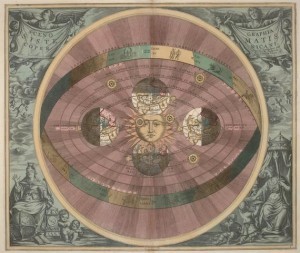Green is an interesting color in astronomy. Our eyes are more sensitive to green than any other color, and so it is a color that is often seen in the night sky. There are green comets, the momentary green brilliance of a meteor, the faint green glow of northern aurora, and even a green glow to some distant galaxies. These objects can have other colors as well, but green is a common color of the night sky.
While all these objects can share a common color, the mechanism behind their greenish glow can vary widely. Comets, for example take on a green hue because of the gas tail that forms as they approach the Sun. Most of the gas consists of hydrogen, but other compounds such as cyanide (CN2) and carbon (C2) can be contained in the tail as well. These molecules emit light at green wavelengths, and can be bright enough to be seen with the naked eye. In fact, cyanide (specifically cyanogen) was the first in Halley’s comet in 1910, and even led to a baseless panic that Earth might be poisoned by Halley’s tail.
Meteors are green for a completely different mechanism. As a meteor enters Earth’s atmosphere, it is heated to the point where its outer layer is vaporized. The metals in the meteor glow with particular colors. Green comes from nickel. The most common metallic meteors are iron-nickel, so green is a common color. This glow tends to be brightest when meteors hit the atmosphere at high speed. For example, fast moving Leonid meteors can often have a green glow.
Galaxies that glow green are known as green pea galaxies. They are compact, and have a strong green emission line from oxygen, making them look like a green pea. The oxygen surrounding the galaxies glows green when it is ionized by the galaxy’s starlight. In order for the oxygen to be bright enough to give the galaxy a green color, there has to be a lot of ionized oxygen, and thus a lot of ultraviolet light produced by young stars. So green pea galaxies are young galaxies where lots of stars are forming, and may have played a role in the reionization of the early universe.
Since we’re most sensitive to green light, why are there no green stars? They can be red, yellow, blue, and white, but not green. It all has to do with the way stars produce light, which is very different from other astronomical objects. Comets, meteors, and the gas around galaxies all give off color when particular atoms or molecules give of light. The electrons in these atoms jump from one energy state to another, emitting a particular wavelength of light. But the Sun and other stars produce light from internal heat. Rather than emitting specific colors, stars emit a range of colors known as a thermal blackbody. The brightest color of a star depends upon its temperature. For cooler stars, the brightest color is red, and thus a star appears reddish. Hotter stars are brightest in the blue range, and so appear blue. But a star that peaks in the green is also bright in red and blue. Thus we see red, green, and blue light from the star, which our eyes interpret as white. Since a thermal blackbody can’t peak at green without being bright in the entire visible spectrum, a green star simply isn’t possible.
But since green is so common in the sky, its absence from the stars is not a big loss.














Comments
Almost all the stars I see are green: perhaps a variation in color sensitivity not amounting to color blindness.